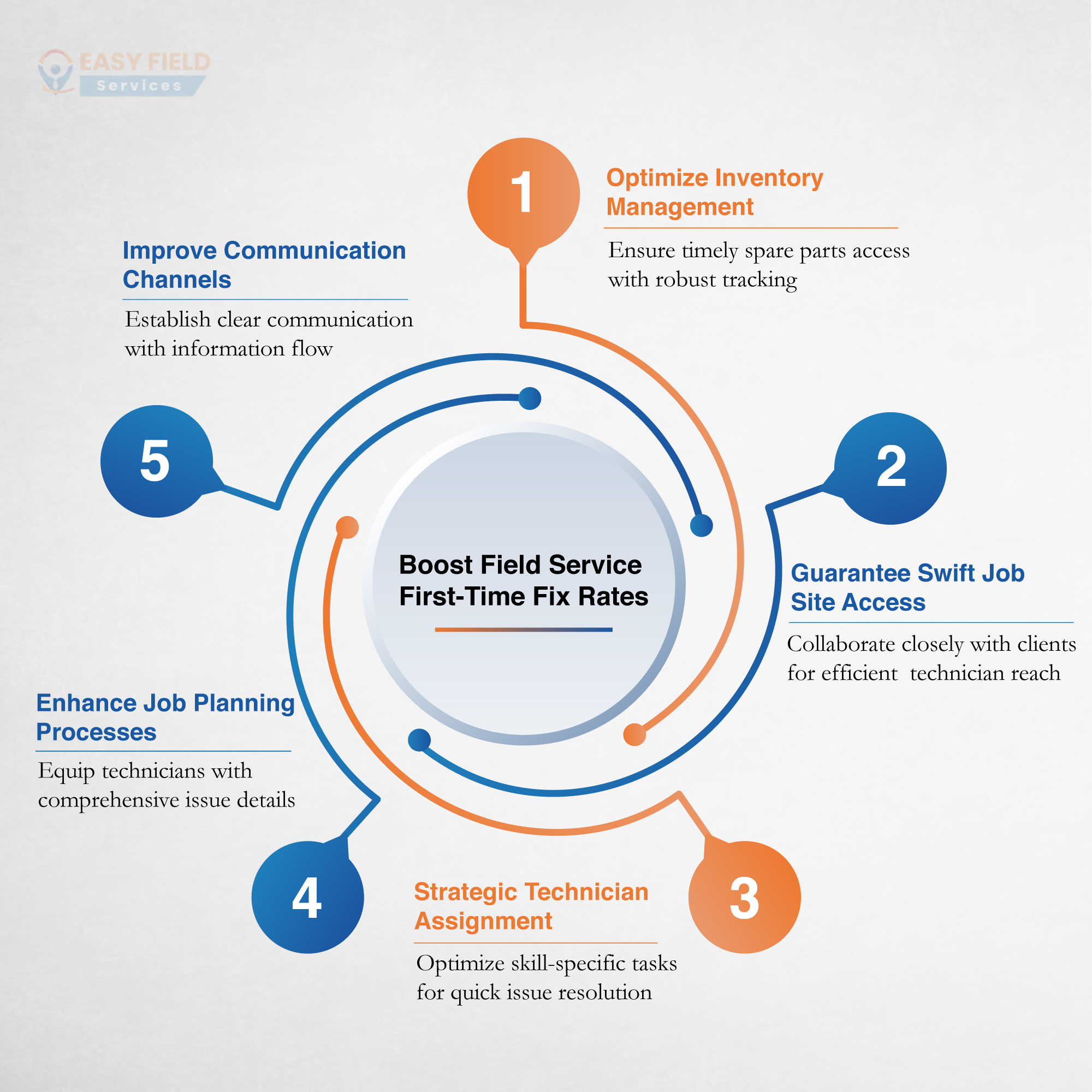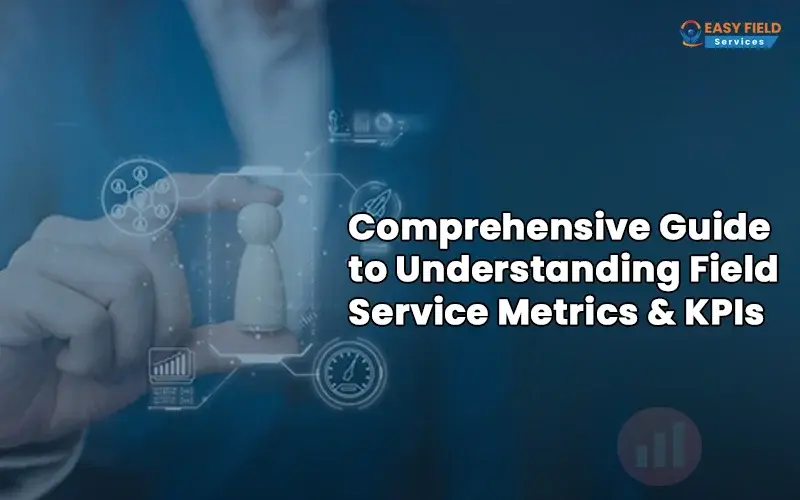How to Measure and Improve First-Time Fix Rate (FTFR) in Field Service?
Overview
- Understanding First-Time Fix Rate
- Calculating First-Time Fix Rate in Field Service Management
- Importance of High First-Time Fix Rate in Field Service Businesses
- Key Areas To Focus in Field Service Industry
- Tips to Increase First-Time Fix Rate in Field Service Management
- Optimize Inventory and Spare Parts Management
- Guarantee Access to Job Sites
- Strategically Assign Skilled Workers
- Enhance Job Planning Processes
- Improve Communication
In field service management, success is often measured by the tricky metric known as the First-Time Fix Rate (FTFR). This crucial benchmark guides field service professionals to resolve issues seamlessly during the first visit, avoiding the need for additional interventions. As we delve into the intricacies of the First-Time Fix Rate, let’s dig into the detailed understanding of what is first-time fixed rate, how to calculate it, why it is an important metric for field service businesses, and what to do to increase an FTFR. This comprehensive exploration is designed to assist field service professionals with the knowledge and insights needed to elevate their operational efficiency and, consequently, their overall business success.
Understanding First-Time Fix Rate
FTFR shows the percentage of problems that technicians solve during the first visit, without needing to come back again. This is a big deal in the field service industry because fixing things on the spot without having to return is a sign that things are running smoothly. It’s like a report card for how well a team is doing in the field service world.
The First-Time Fix Rate is not merely a statistical figure; it is a profound indicator of a field service team’s efficiency. The metric stands as a vital performance benchmark in the field service industry, where achieving resolutions without repeat visits is synonymous with operational excellence. Aiming for a high First Time Fixed Rate is not just a goal but a strategic imperative for businesses operating in the dynamic field service landscape
Calculating First-Time Fix Rate in Field Service Management
FTFR is a measure of how effectively your service team accomplishes their tasks, which includes factors such as the complexity and types of service tasks handled, the experience and skills of your field service agents, and the quality of tools and resources available to the agent. The calculation of the First-Time Fix Rate is a straightforward yet revealing process. Divide the total number of service requests resolved on the first visit by the total service request resolved and the resulting percentage unveils the FTFR. This metric becomes a powerful tool for service organizations to assess their field service team’s effectiveness in achieving resolutions without the need for callbacks. Specific insights can be gained by calculating the First Time Fixed Rate for individual tasks assigned to technicians, providing targeted areas for improvement through training and optimization. The calculation method for first-time fixed rate in field service management is as follows,

You can either manually compute the FTFR or make use of our free first-time fix rate calculator below.
Importance of High First-Time Fix Rate in Field Service Businesses
The significance of maintaining a high First-Time Fix Rate (FTFR) in the landscape of field service management extends well beyond operational efficiency; it forms the solid path for your service business success in this dynamic field service industry. A robust FTFR is a testament to a company’s commitment to delivering seamless service experiences. It is a metric that speaks to the heart of client satisfaction, loyalty, and overall business success.
In an era where client expectations continue to escalate, a high FTFR becomes a crucial differentiator. It is the key to unlocking and sustaining user loyalty. Clients, now more than ever, expect their service issues to be resolved promptly and comprehensively during the initial visit. A high First Time Fixed Rate signals not only operational excellence but also a deep understanding of client needs. While the tangible impact of a high First Time Fixed Rate might not always be quantified in numbers and data its influence on client perceptions is undeniable. Clients remember experiences where their concerns were addressed effectively on the first attempt. This positive interaction not only fosters customer loyalty but also contributes to positive word-of-mouth, which is invaluable in a competitive field service market.
Key Areas To Focus in Field Service Industry
To align practices with client expectations, foster loyalty, and stand out as leaders in the industry, service business owners should focus on:
- Prioritizing client time and valuing their concerns
- Communicating a positive brand image through reliability
- Understanding the ongoing commitment needed for a high FTFR
- Recognizing the strategic significance of FTFR for sustained success in the dynamic field service arena.
In the upcoming passages, we will delve deeper into the strategic implications of First Time Fixed Rate, exploring how service business owners can align their practices with client expectations, foster loyalty, and stand out as leaders in the field service arena. Let’s continue on this path of understanding and implementing the principles that drive FTFR and, consequently, overall business success.
Tips to Increase First-Time Fix Rate in Field Service Management

Time window scheduling focuses on optimizing on-time performance by specifying predefined time frames for field service task completion. This algorithm is particularly beneficial in field service industries where strict adherence to timelines is critical, such as emergency response services or scheduled maintenance. By establishing time windows for field service task completion you can ensure that services are delivered within specified timeframes, contributing to increased reliability and client satisfaction. However, it’s essential to strike a balance between stringent time constraints and the practicalities of field service task completion to avoid potential challenges and ensure operational effectiveness.
Optimize Inventory and Spare Parts Management
Efficient inventory management is not just about having the right parts; it’s about having them at the right time. Implementing a robust inventory tracking system ensures that technicians not only have easy access to the necessary spare parts but also that these components are readily available when needed. Regularly reviewing and updating stock levels is a proactive measure that prevents delays in service due to the unavailability of essential components. By maintaining a well-organized and up-to-date inventory, businesses can minimize downtime, boost technician productivity, and ultimately contribute to a higher First-Time Fix Rate (FTFR).
Guarantee Access to Job Sites
Timely access to job sites is essential for achieving a high First Time Fix Rate. Collaborating closely with clients to ensure technicians can reach service locations without unnecessary delays. Addressing logistical challenges in advance, such as obtaining necessary permissions or coordinating access, streamlines the service process. This proactive approach not only prevents avoidable delays but also demonstrates a commitment to efficient service delivery. By guaranteeing swift access to job sites, businesses can lay the foundation for successful first-time issue resolution, fostering customer satisfaction and operational excellence.
Strategically Assign Skilled Workers
Assigning the right technicians to specific jobs is similar to assembling a specialized task force. Beyond availability, it involves a strategic assessment of skills, expertise, and experience. When scheduling appointments, considering the unique proficiencies of each technician ensures a tailored approach to problem-solving. Matching the right technician to the right task significantly increases the likelihood of a successful first-time fix. This strategic alignment not only optimizes the use of resources but also enhances customer satisfaction by delivering efficient and effective solutions on the initial visit. In essence, strategic technician assignment is significant in the pursuit of an elevated First Time Fixed Rate.
Enhance Job Planning Processes
Efficiency in job planning is more than just scheduling appointments; it’s about empowering technicians with the right information. Streamlining job planning processes involves providing comprehensive details about the issue, customer history, and any relevant documentation. Equipping technicians with this wealth of information ensures they are well-prepared for each service call. Effective job planning not only reduces service diagnosis time or mean time to repair but also increases the chances of resolving issues on the first visit. By fostering a culture of thorough preparation and information sharing, businesses can elevate their FTFR and deliver a consistently high standard of service.
Improve Communication
In the realm of field service management, effective communication is a crucial aspect of service success. Enhancing communication channels between dispatchers, technicians, and clients goes beyond mere connectivity; it’s about creating a seamless flow of information, real-time updates, clear instructions, and proactive communication contributing significantly to a higher FTFR. Technicians armed with timely and relevant information can navigate service calls more efficiently, reducing the likelihood of revisits. By investing in robust communication infrastructure and practices, field service businesses can not only elevate their FTFR but also enhance overall operational cohesion and customer satisfaction. Wrapping up, the First-Time Fix Rate is not just a metric; it is a reflection of a field service management business’s commitment to excellence.
Achieving a high First Time Fixed Rate is a strategic imperative, that impacts customer satisfaction, retention, and overall operational efficiency. As field service professionals navigate the challenges of their industry, optimizing the FTFR becomes a foundation for success. The tips provided offer actionable strategies to elevate the First Time Fixed Rate, empowering businesses to deliver exceptional service and thrive in the competitive landscape of field service management. To embark on this journey of operational excellence, seize the opportunity to implement these insights and witness the transformative impact on your field service management business.





